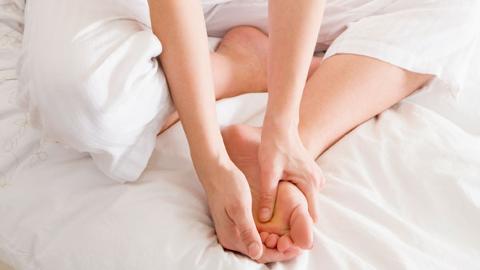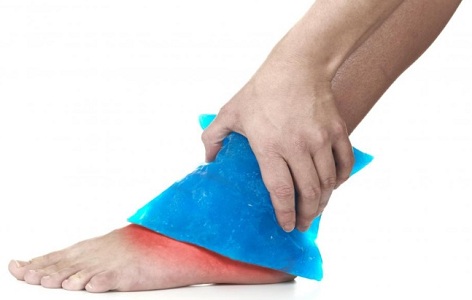Muscle cramps are sudden involuntary contractions which may occur in different parts of your body. The commonly affected areas include the feet, arms, abdominal wall, and hands. The intense pain can awaken you if you are asleep or make it difficult for you to move or walk during the day. They are often caused by muscle spasms and almost everyone experiences muscle cramps once in his or her lifetime. You can find the detailed causes and available treatment methods below.

Possible Causes of Cramps in Hands and Feet
1. Inadequate Blood Supply
Inadequate blood supply is a condition that occurs when the arteries which supply blood to the arms and legs, narrow down in a situation called arteriosclerosis. This condition results in cramps-like pain in the legs, feet, or arms, especially during workouts. However, the pain goes away immediately after you stop the workout.
2. Nerve Compression
Compression of the nerves on the lumbar stenosis or spinal cord is a common contributor to cramp-like pain on the hands and legs. The pain can worsen if you try to walk. Walking in a tightening position such as pushing a cart in front of you may improve the symptoms.
3. Mineral Depletion
Medical research has shown that a low level of different minerals is known to cause cramps. A reduction in the levels of magnesium, calcium, or potassium in the diet can contribute to cramps on the hands and legs. Moreover, medications such as diuretics prescribed for hypertension or high blood pressure can contribute to mineral depletion.
4. Age
When we age, we begin to lose muscle mass, and the remaining muscle mass is over-stressed. In most cases, the elderly or senior citizens experience cramps in hands and feet because the muscles can no longer support their weight.
5. Dehydration
People who participate in sports in warm weather are likely to experience cramps in the feet and hands because the exercise leads to dehydration. Dehydration of the muscle results in the reduction of the muscle flexibility, leading to cramps.
6. Pregnancy
While fatigue, morning sickness, and back pain are frequent complains during pregnancy, raised hormonal levels also cause the retention of water during pregnancy, resulting in swollen legs. Cramps occur because the cells are stressed with excess fluid and movement becomes a problem. Fluid retention also causes partial blockage of the blood flow to different parts of the body.
7. Medical Conditions
Recent findings indicate that there are medical conditions which increase the risk of cramps of the feet and hands. The diseases include thyroid disorders, liver problems, nerve diseases, and diabetes. In addition, brain disorders and conditions such as dystonia, multiple sclerosis, and Huntington disease can contribute to the cramps.
How to Relieve Cramps in Hands and Feet
Cramps can be treated using various self-care measures. However, when it's interfering with your daily life and does not respond to the home remedies, seek medical advice as soon as possible.
1. Warm Compress
 When you put a heating pad on areas affected by cramps, the temperature would raise gradually and the pain can be relieved as the heat relaxes the muscles and encourages blood flow. If the pain does not subside after ten minutes of application, you can wait for half an hour before applying again. The effect of warm compress may be increased when having gentle massage on the affected area as well.
When you put a heating pad on areas affected by cramps, the temperature would raise gradually and the pain can be relieved as the heat relaxes the muscles and encourages blood flow. If the pain does not subside after ten minutes of application, you can wait for half an hour before applying again. The effect of warm compress may be increased when having gentle massage on the affected area as well.
2. Foods Rich in Acetic Acid
 It is recommended that you consume foods rich in acetic acid as it alleviates the cramps. Drink pickle juice, apple cider vinegar or eat mustard because they contain acetic acid. Acetic acid is required in the synthesis of acetylcholine, improving muscle coordination and functionality.
It is recommended that you consume foods rich in acetic acid as it alleviates the cramps. Drink pickle juice, apple cider vinegar or eat mustard because they contain acetic acid. Acetic acid is required in the synthesis of acetylcholine, improving muscle coordination and functionality.
3. Herbal Tea
 Studies indicate that anxiety and stress could be the causes of cramps in hands and feet. Taking a cup of chamomile tea will help in relaxing your body, and this will, in turn, reduce cramps and muscle aches. Alternatively, you can take cramp bark tea. The tea has valerenic acid which is a muscle relaxant and helps in relieving cramps.
Studies indicate that anxiety and stress could be the causes of cramps in hands and feet. Taking a cup of chamomile tea will help in relaxing your body, and this will, in turn, reduce cramps and muscle aches. Alternatively, you can take cramp bark tea. The tea has valerenic acid which is a muscle relaxant and helps in relieving cramps.
4. Stretching
 Cramps which affect the legs and feet can be reduced effectively by walking around or through stretching. If you are experiencing cramps on your calf muscle, you can stand two feet from the wall and stretch your feet. Another way of reducing cramps on the feet is through flexing the ankle. This can be done through pulling the toe towards the head with the legs as straight as possible. If you are experiencing cramps on your hand, press the hand on the wall with fingers facing down.
Cramps which affect the legs and feet can be reduced effectively by walking around or through stretching. If you are experiencing cramps on your calf muscle, you can stand two feet from the wall and stretch your feet. Another way of reducing cramps on the feet is through flexing the ankle. This can be done through pulling the toe towards the head with the legs as straight as possible. If you are experiencing cramps on your hand, press the hand on the wall with fingers facing down.
5. Medications
 There are various muscle relaxant medications in the market such as orphenadrine, baclofen, and cyclobenzaprine. These medications are essential in alleviating stiff muscle conditions. In case you experience muscle cramps regularly, you can drink quinine containing water or tonic water before bed. In some cases, injection of botulinum toxin can help prevent muscle problems associated with spastic muscle disorders.
There are various muscle relaxant medications in the market such as orphenadrine, baclofen, and cyclobenzaprine. These medications are essential in alleviating stiff muscle conditions. In case you experience muscle cramps regularly, you can drink quinine containing water or tonic water before bed. In some cases, injection of botulinum toxin can help prevent muscle problems associated with spastic muscle disorders.
How to Prevent Cramps in Hands and Feet
1. Eat Bananas
Any electrolyte imbalance in the system caused by a dietary imbalance, or excessive sweating can affect the function of the muscles. Low levels of potassium, or sodium can make you susceptible to cramps. Bananas contain a high level of potassium and eating a banana every day will help in balancing your potassium and sodium levels.
2. Take Plenty of Fluids
Dehydration is known to be a common cause of muscle cramps. You can become dehydrated if you sweat a lot. Increasing the amount of water intake to the recommended amount of eight 8-ounce glasses a day will keep you hydrated and help the muscle regain activity.
3. Drink Tonic Water
Tonic water is a common carbonated beverage which contains quinine, and this is known to be an effective muscle relaxant and improves myoblastic activity. Research shows that if you take one 12-ounce can of the drink, cramps in hands and feet will be a history.
